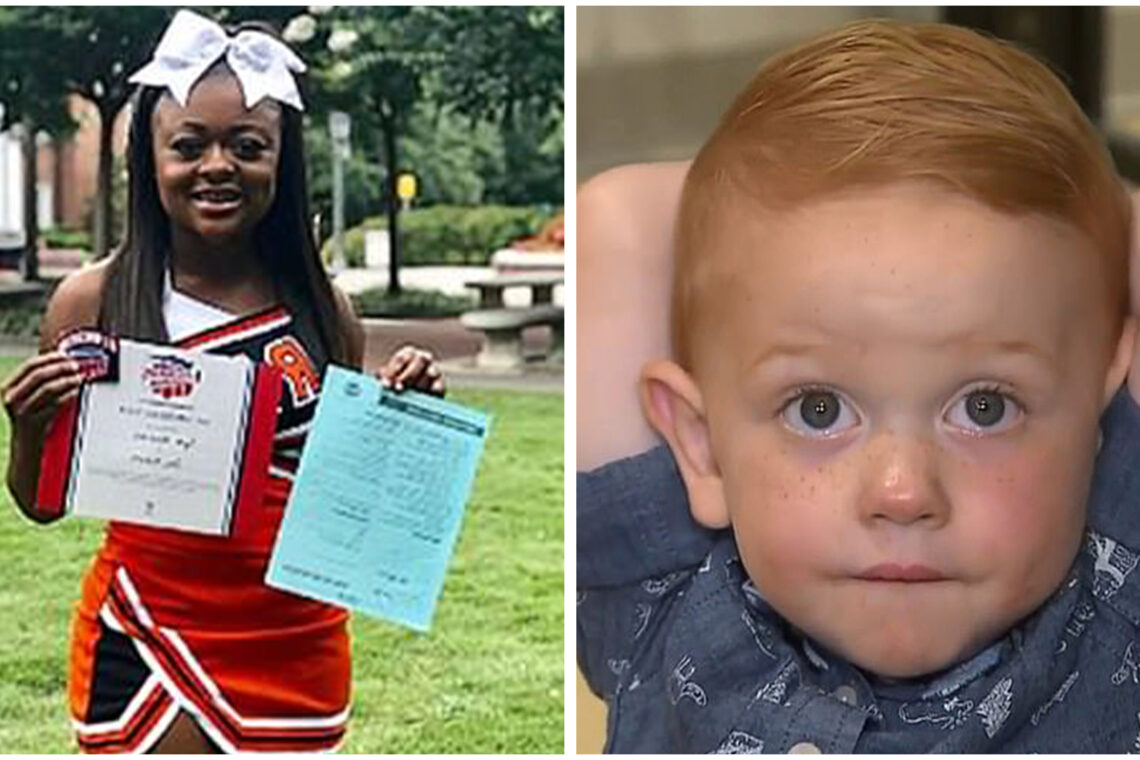
In a remarkable incident that highlights the importance of basic life-saving skills, a young Texas cheerleader became a beacon of hope during a homecoming parade. This heartwarming narrative revolves around a 17-year-old cheerleader named Tyra Winters, who found herself amidst a life-threatening situation when she spotted a mother desperately seeking help for her choking toddler.
The event unfolded during a festive parade in 2019, where Tyra was riding on a float alongside her teammates from Rockwall High School, situated near Dallas. The atmosphere was vibrant with the cheers of excited attendees, but the excitement took a drastic turn when a cry for assistance pierced through the joyful noise.
As Tyra glanced into the crowd, she noticed a young boy whose face was rapidly changing color, signaling a dire emergency. The toddler, named Clarke, was choking on a piece of candy, and his distress was evident as his face turned a deep shade of red. Recognizing the severity of the situation, Tyra acted swiftly and decisively, becoming a true embodiment of bravery and quick thinking.
In a moment that would define her as a hero, Tyra leaped off the float and made her way through the crowd, intent on reaching the young boy. The sight of Clarke’s condition was alarming; he was beginning to show signs of asphyxiation, his skin starting to take on a purplish hue. Without a second thought, she picked him up and positioned him correctly for the procedure she needed to perform.
Drawing upon the training she had received, Tyra employed the Heimlich maneuver—an emergency technique that can clear an obstructed airway. As she tilted Clarke downward, she delivered a series of firm back thrusts. Her actions were executed with precision, and it wasn’t long before the toddler began to spit out the obstruction that was choking him. This critical intervention was not only a display of Tyra’s knowledge but also her innate willingness to help someone in peril.
Clarke’s mother, Nicole Hornback, had initially attempted to dislodge the candy from her son’s throat but was met with frustration and fear. She recounted the experience, describing the sheer terror that engulfed her as she helplessly clutched her child. In her moment of desperation, she had been frantically trying to pass him to anyone who could assist, when Tyra emerged as the guardian angel of that day.
After the incident, Nicole expressed immense gratitude for Tyra’s bravery. She articulated the weight of the situation, stating that it was one of the most terrifying moments she had ever faced as a parent. In a heartfelt acknowledgment, she stated, “She saved my baby.” The bond formed between the two women was solidified during their reunion, just days after the parade, when they embraced, sharing a moment that transcended the chaos of that day.
Tyra attributed her ability to perform the life-saving maneuver to her mother, who had instilled in her the importance of being prepared for emergencies. This foundation of knowledge empowered Tyra to react effectively when it truly mattered. The entire episode serves as a poignant reminder of how vital it is for young people to be educated in life-saving techniques.
The story of Tyra Winters and Clarke Hornback resonates beyond just a singular event; it embodies the essence of community, responsibility, and the impact one individual can have in a moment of crisis. It underscores the necessity for awareness and training in life-saving skills, which can be crucial in emergencies. Such education can come from various sources, be it parents, schools, or community programs, and it is clear that it can make a significant difference in critical situations.
Moreover, Tyra’s actions exemplify the character traits that should be celebrated in today’s youth. In an age where many young people are often criticized, Tyra’s courage and quick response stand out as an inspiring example for her peers. It is imperative to recognize and commend young individuals who take initiative in the face of adversity and to encourage the sharing of knowledge regarding life-saving skills among them.
This narrative also highlights the importance of community support and training in basic first aid. It serves as a call to action for parents to equip their children with the necessary tools to respond to emergencies, ensuring that they can act confidently when faced with challenging situations. Teaching children how to handle choking, perform CPR, or manage other first-aid scenarios can cultivate a generation that is not only aware but also capable of making a difference in urgent circumstances.
In the aftermath of this event, the conversations surrounding the importance of basic life-saving training have gained momentum. Schools and communities are encouraged to implement programs that teach these essential skills, fostering an environment where young individuals feel empowered to act. Tyra’s story is a testament to the fact that preparation can save lives, and it inspires others to follow in her footsteps.
The bond forged between Tyra and Clarke’s family is a powerful reminder of the interconnectedness of human experiences. Their story continues to inspire individuals across the nation, illustrating the profound impact that one person’s bravery can have on another’s life. It encourages a culture of preparedness and compassion, urging everyone to recognize the potential within themselves to be heroes in their own communities.
As we reflect on this inspiring event, let it serve as a catalyst for discussions about the importance of learning life-saving skills. May we all strive to be better equipped to handle emergencies, fostering a community where everyone feels empowered to step in when help is needed.